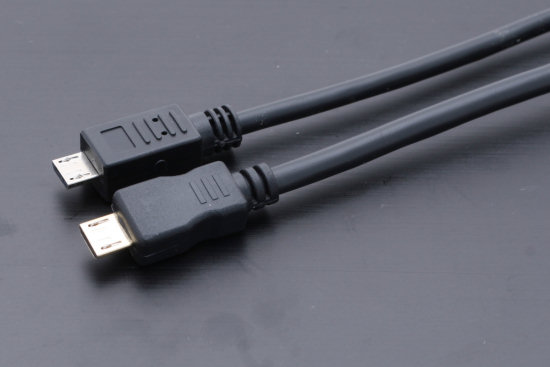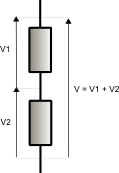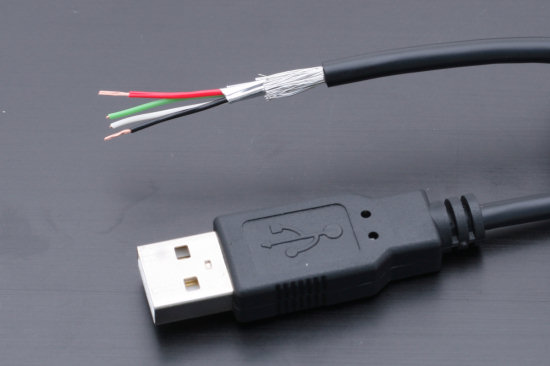![]() One may think that USB cables are quite equivalent. Why spend tens of dollars on a so-called "top quality" cable while cheap cables are available from Internet. Well, that's a good question.
One may think that USB cables are quite equivalent. Why spend tens of dollars on a so-called "top quality" cable while cheap cables are available from Internet. Well, that's a good question.

Are these two Micro-B USB Cables equivalent?
Before answering, we have to talk about two fundamental laws used in electricity, you probably heard about them back at school, but a little refresher wouldn't hurt.
The Ohm's law states that the potential difference (in volts) across a an electric conductor is equal to its internal resistance (in ohms) times the current (in amperes) going through it. This law is known as V = R . I.

The voltage (V) across an electric conductor is equal to its resistance (R) times the current going through it (I)
An other law states that voltage across a group of series connected conductors is equal to the sum of the voltage across each of them..

Voltage across series connected conductors should be added
Well these two laws have consequence on USB cables. Back at school you were told that cables resistance was zero. Well you've been lied to :-) Most of the time electric cables have a negligible resistance, but it's never zero.
That's why an USB device plugged at one end of an USB cable acts as it was between two small resistors: one for the VCC wire and one for the GND one (thoses a the red and black power wires). Some of the energy will be dissipated in the wires.
So lets call Rp the positive wire resistance, Rm the negative wire resistance, Vusb the voltage at the host end of the cable and I the current going across the cable.Then the voltage at the device end will be Vusb - I.(Rp + Rm).

Wires in the USB cable act as resistors, this changes the voltage at the device end of the cable
Therefore it's quite easy to easy to understand why the cable resistance shouldn't be too high, especially when the device draws a lot of current.
The USB specifications states ratings about that: the host should be able to give from 4.65 to 5.25 volts on the USB plug, and an USB device should be able to work properly with as least 4.4v.
Enough theory. Lets go for some practical tests. We measured the total resistance ( negative and positive wire) of some usb cable on the market. So we can decide if USB cables are equivalent or not.
| Brand (length) | Resistance (ohms) |
|---|---|
| Generic cable(0.3m) | 0.289 |
| Generic cable (1m) | 0.598 |
| Delock (1m) | 0.256 |
| Nokia (1.2m) | 0.526 |
| Delock (2m) | 0.264 |
| Manhattan (5m) | 1.429 |
At first sigh the highest resistance is 5 times the lowest. It's quite easy to compute the voltage drop according to the device current draw. The table below shows the voltage on the device's end of the cable in the worst case (4.65 v on the host end).
| Brand | 50 mA | 100 mA | 150 mA | 200 mA | 300 mA | 400 mA | 500 mA |
|---|---|---|---|---|---|---|---|
| Generic cable (0.3m) | 4.64v | 4.62v | 4.61v | 4.59v | 4.56v | 4.53v | 4.51v |
| Generic cable (1m) | 4.62v | 4.59v | 4.56v | 4.53v | 4.47v | 4.41v | 4.35v |
| Delock (1m) | 4.64v | 4.62v | 4.61v | 4.60v | 4.57v | 4.55v | 4.52v |
| Nokia (1.2m) | 4.62v | 4.60v | 4.57v | 4.54v | 4.49v | 4.44v | 4.39v |
| Delock (2m) | 4.64v | 4.62v | 4.61v | 4.60v | 4.57v | 4.54v | 4.52v |
| Manhattan (5m) | 4.58v | 4.51v | 4.44v | 4.36v | 4.22v | 4.08v | 3.94v |
Actually in real life, an USB device disconnect itself from the USB bus before the 4.4v volt threshold is reached. This does not mean the device ceases to work: it is just disconnected from the bus, it might still working on its own. If the voltage raises again, it will probably reconnect itself.

USB wires are so thin they cannot give a lot of power.
So the conclusion is: the wires inside an USB cable are terribly thin. the thinner/longer they are, the higher their resistance is. That's why they cannot deliver a lot of power. As a general rule, if your USB device need less than 200mA, you're probably safe. Otherwise you need to chose your cables carefully. No cable manufacturer will provide their cable resistance, but you can use the following rule: keep your cables as short as possible, and stay away from thin cables.


